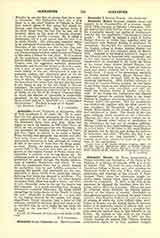

Alexander Briant, BLESSED, English Jesuit and martyr, b. in Somersetshire of a yeoman family about 1556; executed at Tyburn, December 1, 1581. He entered Hert Hall, Oxford, at an early age, where his remarkable beauty and purity of countenance won for him the appellation, “the beautiful Oxford youth”. At Oxford he became a pupil of Father Robert Persons to which fact, together with his association with Richard Holtby, is attributed his conversion. Having left the university he entered the English college at Reims, whither Holtby had preceded him, and was ordained priest March 29, 1578. Assigned to the English mission in August of the following year he labored with exemplary zeal in his own county of Somersetshire. During his ministrations he reconciled to the Faith the father of his former tutor, Father Robert Persons, and the intimacy resulting from this fresh tie between pupil and master probably led to the former’s untimely death. A party of the persecution, searching for Father Robert Persons, placed Blessed Alexander under arrest, April 28, 1581, in the hope of extorting information. After fruitless attempts to this end at Counter Prison, London, he was taken to the Tower where he was subjected to excruciating tortures. To the rack, starvation, and cold was added the inhuman forcing of needles under the nails. It was during this confinement that Blessed Alexander penned his pathetic letter to the Jesuit Fathers in England requesting admission into the Society, which was granted. But his membership was shortlived; together with six other priests he was arraigned, November 16, 1581, in Queen’s Bench, Westminster, on the charge of high treason, and condemned to death. The details of this last great suffering, which occurred on the December 1 following, like those of the previous torture are revolting. Through either malice or carelessness of the executioner he was put to needless suffering. His face is said to have been strikingly beautiful even up to his death. In his letter to the Jesuit Fathers he protests that he felt no pain during the tortures he underwent, and adds: “Whether this that I say be miraculous or no, God knoweth”. He was scarcely more than twenty-five years of age at the time of his martyrdom.
E. F. SAXTON

